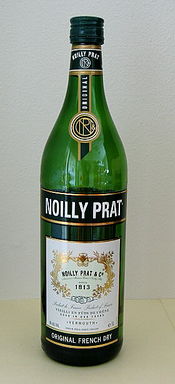Vermouth

Vermouth (pronounced ver-mooth /vərˈmuːθ/) is a fortified wine, flavored with aromatic herbs and spices ("aromatized" in the trade) such as cardamom, cinnamon, marjoram and chamomile.[1] Some vermouth is sweetened; unsweetened, or "dry" vermouth tends to be bitter. The person credited with inventing the vermouth recipe, Antonio Benedetto Carpano from Turin, Italy, chose to name his concoction "vermouth" in 1786 because he was inspired by a German wine flavoured with wormwood, a herb most famously used in distilling absinthe.[2][3] The modern German word Wermut (Wermuth in the spelling of Carpano's time) means both wormwood and vermouth. The herbs in vermouth were originally used to mask raw flavours of cheaper wines, imparting a slightly medicinal "tonic" flavour.
Contents |
Uses
In addition to creating cocktails, vermouth can be used in place of white wine in cooking. Since it is fortified and shelf-stable, it makes a good substitute to keep on hand for cooking purposes since it will not sour as white wine can.
Cocktails
Vermouth is used in many cocktails, where it serves as a moderating agent to reduce the percentage of alcohol by volume in the drink and provide an herbal flavor. In his book The Joy of Mixology, Gary Regan categorizes these drinks as "French-Italian cocktails" because dry vermouth was traditionally referred to as French vermouth and sweet vermouth was traditionally referred to as Italian vermouth. The most well-known cocktails containing vermouth are the Martini and the Manhattan.
Cocktails containing vermouth
- Algonquin — rye, dry vermouth, pineapple juice
- Bamboo — dry sherry, dry vermouth
- Blood and Sand Cocktail — Scotch, sweet vermouth, orange juice, cherry-flavored brandy
- Bronx — gin, dry vermouth, sweet vermouth, and orange juice
- Crystal Bronx - sweet vermouth, orange juice, dry vermouth and soda water
- Chocolate Soldier — gin, vermouth, juice of half a lime, shaken
- Corpse Reviver #1 — brandy, apple brandy, and sweet vermouth
- Gibson — gin and dry vermouth, garnished with pearl cocktail onions
- Income Tax Cocktail — gin, dry vermouth, sweet vermouth, orange juice, and aromatic bitters
- Ingrid - 2/3 beer and 1/3 vermouth
- Man O'War — bourbon, curaçao, sweet vermouth, lemon juice, garnished with an orange slice and a lemon slice. Named after the racehorse Man o' War.
- Martinez — gin, sweet vermouth, aromatic bitters, sugar syrup
- Martini — gin or vodka and dry vermouth
- Manhattan — rye or Canadian whisky, sweet vermouth, and Angostura bitters
- Negroni — equal parts gin, sweet vermouth, and Campari
- Mephisto — gin, dry and sweet (perfect) vermouth, orange bitters, absinthe, simple syrup and Scotch Whisky.
- Pall Mall — gin, sweet vermouth, vermouth, and white cream de cacao
- Rob Roy — Scotch whisky, sweet vermouth and a dash of Angostura bitters
- Satan's Whiskers — gin, dry vermouth, sweet vermouth, orange juice, orange liqueur, and orange bitters.
- Nice Communist — Sweet Vermouth, Vanilla Vodka, and Apple juice.
El Presidente
| Type | Cocktail |
|---|---|
| Primary alcohol by volume | |
| Served | Straight up; without ice |
| Standard garnish |
twist of orange peel |
| Standard drinkware |
|
| Commonly used ingredients |
|
| Preparation | stir well with ice, then strain into glass. Garnish and serve. |
The El Presidente is a mix of rum, curacao, and vermouth. The El Presidente originated in Havana, Cuba and was popular from the 1920s through the 1940s.[4] The cocktail was named in honor of Cuban President Gerardo Machado and quickly became the preferred drink of the Cuban upper class.
Satan's Whiskers
Satan's Whiskers is a drink containing gin, dry vermouth, sweet vermouth, orange juice, Grand Marnier or curaçao, and orange bitters. It is shaken and served without ice. There are two versions, "straight" with Grand Marnier and "curled" with curaçao.
The first recipe for Satan's Whiskers is from 1930 in Harry Craddock's Savoy Cocktail Book.[5]
Styles
There are three general styles of vermouth, in order from driest to sweetest: extra dry, bianco/white, and sweet/red. Sweet red vermouth is drunk as an apéritif, often straight up, as well as in mixed drinks like the Manhattan. Dry white vermouth, along with gin, is a key ingredient in the mixing of martinis. Red vermouths are sometimes referred to as Italian vermouths and white vermouths as French vermouths, although not all Italian vermouths are red and not all French vermouths are white.
See also
- History of alcoholic beverages
- Cinzano
- Gancia Originale
- Martini (vermouth)
- Noilly Prat
- Punt e Mes
- Dolin
References
- ↑ Clarke, Paul (15 August 2008). "The Truth About Vermouth: The secret ingredient in today's top cocktails remains misunderstood". San Francisco Chronicle. http://www.sfgate.com/cgi-bin/article.cgi?f=/c/a/2008/08/15/WI0111LMMB.DTL. Retrieved 6 April 2009.
- ↑ http://casadeltequila.ch/index.php?main_page=product_info&products_id=269
- ↑ wermut at BEOLINGUS and Wiktionary
- ↑ Curtis,Wayne (May. 1, 2006). El Presidente. Lost Magazine.
- ↑ Ted Haigh (2004). Vintage Spirits and Forgotten Cocktails. Quarry Books. pp. 144. ISBN 1592530680.
|
||||||||||||||||||||||||||||||||||||||||||||||||||||||||||||||||||||||||